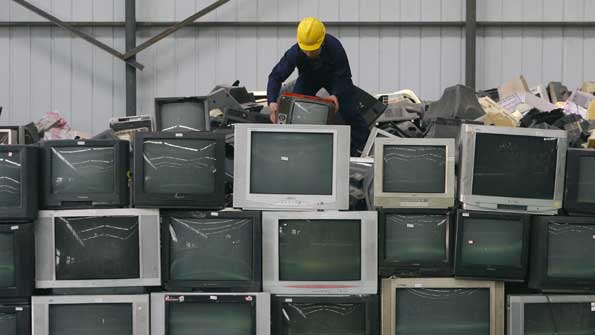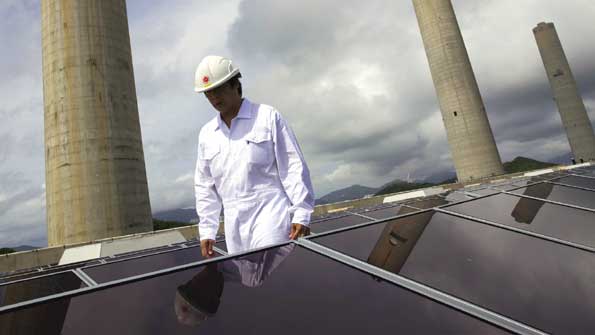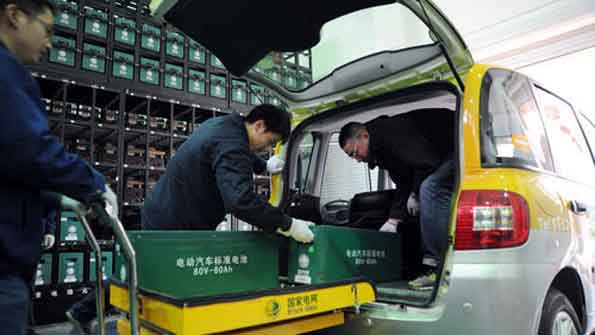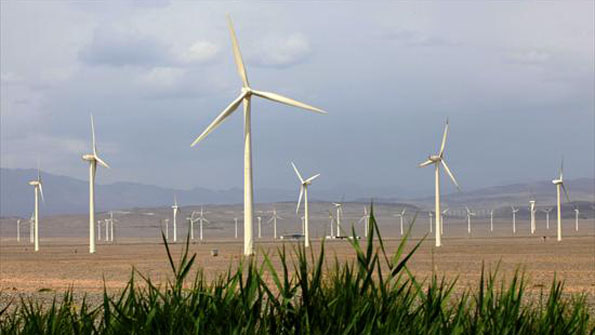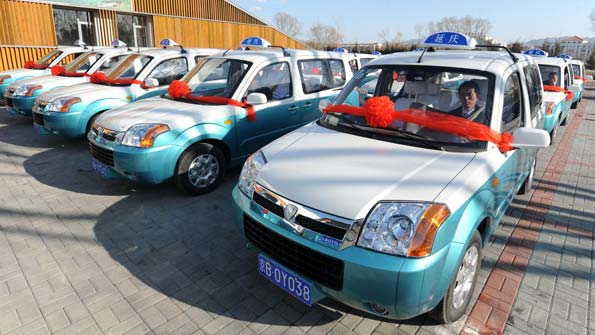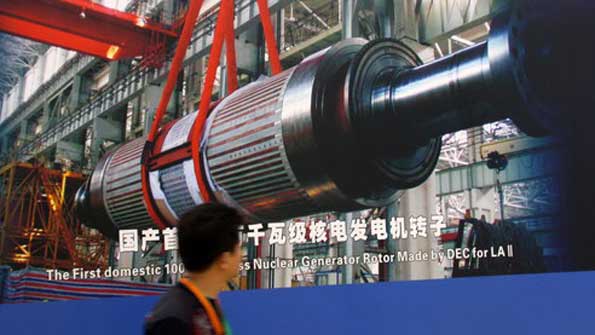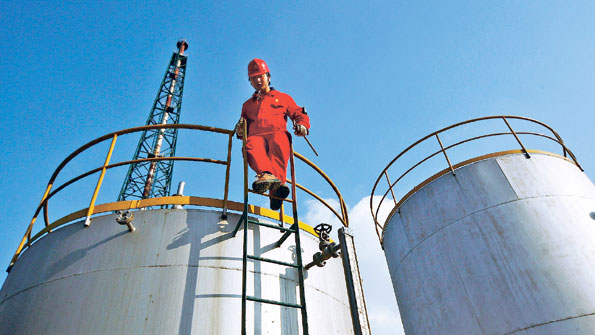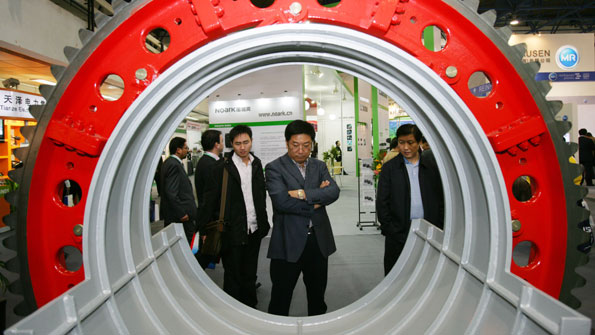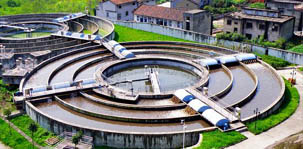Nuclear crisis energizes grid, wind power efforts
[2011-04-12 11:20]China is stepping up construction of its electric grid infrastructure, an important move amid the international doubts about the safety of the nuclear industry following the crisis in Japan.
Recycling is rolling forward in 55 cities
[2011-04-11 10:07]Seventy percent of renewable resources in 55 cities are being collected for recycling, up from the 40 percent in 2006.
Suntech and Peak International win UN green-energy contract
[2011-04-06 13:41]Suntech Power Holdings Co Ltd and Peak International Trade (Tianjin) Co Ltd, have won a $81 million contract to provide portable solar power systems to UN peacekeeping missions.
China may double solar power capacity goal
[2011-04-01 11:22]China, the world's largest solar panel exporter, is likely to boast 10 gigawatts (gW) of solar power capacity by 2015 from the current 1 gW, doubling its existing target amid rising doubts about the safety of nuclear power.
Solar power plant built in Tibet
[2011-03-31 16:37]Solar panels are set in Xigaze in the Tibet autonomous region, March 30, 2011.
China may double solar goal after Japan nuclear leak
[2011-03-30 11:20]China may double its target for photovoltaic power capacity over the next five years in the wake of Japan's nuclear crisis, Reuters reported, citing a China Securities Journal report.
MIIT announces to develop smart grid and UHV
[2011-03-28 13:33]The Ministry of Industry and Information Technology (MIIT) will push three initiatives to develop environmentally-friendly energy equipment industry.
China to impose rare earth resource tax from April 1
[2011-03-24 17:51]China will impose a tax on rare earth minerals starting April 1, according to a statement issued jointly by the Ministry of Finance and the State Administration of Taxation to rare earth producers.
Nuclear power standards come under scrutiny
[2011-03-22 10:58]China Guangdong Nuclear Power Group Co, the majority owner of the Daya Bay plant near Hong Kong, is conducting safety checks on its power stations, including those under construction, following the Japan nuclear crisis.
Miao: 100b yuan boost to alternatives
[2011-03-14 13:32]The central government will spend 100 billion yuan ($14.87 billion) over the next decade to support development of new energy and energy-saving vehicles in China, according to Miao Wei, head of the Ministry of Industry and Information Technology.
Xinjiang spends heavily on wind power industry
[2011-03-03 16:36]Northwest China's Xinjiang Uygur autonomous region plans to spend 20 billion yuan ($3.04 billion) this year to boost its wind-power industry, including the establishment of the region's largest production base for wind-power turbines in Hami.
50 electric cabs hit Beijing streets
[2011-03-02 10:56]A fleet of 50 electric cabs started operation in the Chinese capital Beijing on Tuesday. Each of the electric cabs can run 140 kilometers on full battery and saves more than 30,000 yuan on fuel per year.
Nuclear power sector target too 'aggressive', says expert
[2011-02-09 09:29]An "over-aggressive" target for the nuclear power industry by 2020 may harm the sector's healthy development, an industry expert from the National Development and Reform Commission's (NDRC) think tank cautioned.
Natural gas demand to soar
[2011-01-29 09:06]China's natural gas demand will rise 20 percent in 2011 to 130 billion cubic meters (cu m) and production will increase 16 percent to 110 billion cu m, according to a statement from the National Energy Administration (NEA) on Jan 28.
Foreign markets boost CNEEC
[2011-01-25 13:58]China National Electric Engineering Co Ltd (CNEEC) says it secured most of its 2010 revenue from overseas power station projects, representing the Chinese contractor's capacity in the international Engineering, Procurement and Construction (EPC) market.
China makes flurry of energy deals with US firms
[2011-01-20 09:34]China's National Energy Administration and the United States Department of Energy signed 18 deals worth $13 billion on Tuesday, ushering in President Hu Jintao's four-day state visit to the United States.
 China, US reach $45 billion in export deals
China, US reach $45 billion in export deals
Uranium shortage likely to end in 10 years: CNNC
[2011-01-18 11:17]It will take at least a decade for China to start the large-scale industrial application of spent fuel reprocessing technology, which may be the solution to the supply shortage, the China National Nuclear Corp (CNNC) said on Monday.
China's installed wind power capacity tops world
[2011-01-17 16:37]China became the country with the world's largest installed wind power capacity at the end of 2010, Guangzhou Daily reported Monday, citing information from the China Association of Resource Comprehensive Utilization.
China beats emission reduction target
[2011-01-14 16:55]China exceeded its target on reducing pollutant emission during the 11th Five-Year Plan from 2005 to 2010, according to the Ministry of Environmental Protection on Jan 13. A total of 500 million kilowatts of desulfurization facilities in coal-fired power plants has been built and the urban sewage treatment rate had reached 75 percent, 23 percent more than in 2005.
Shoppers more green-savvy than biz
[2011-01-13 14:21]The demand for green products and services appears to be skyrocketing in China, but businesses are underestimating consumer interest and awareness in environmental issues, according to TUV SUD Asia Pacific.


